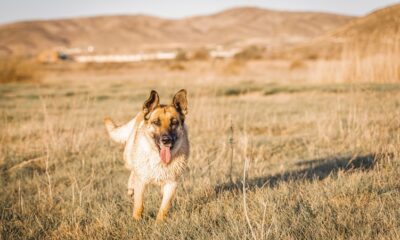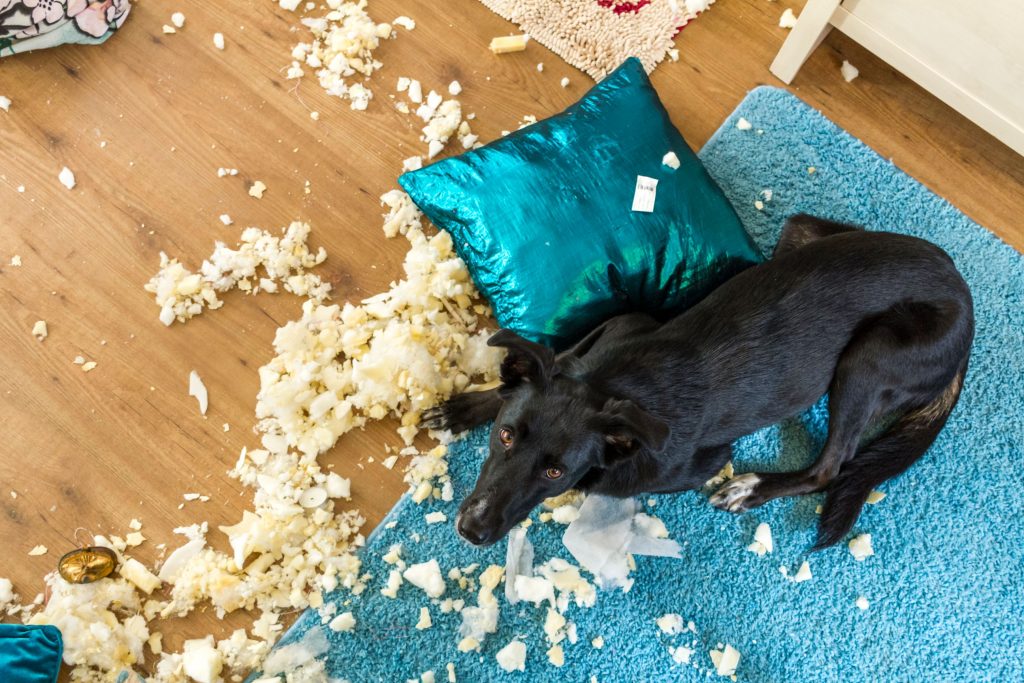Aggression towards other dogs is a common problem. Dogs that are very sweet at home can be real dramas outside of other dogs. If they meet another dog, be it a male or a female, they will display behavior that makes the owner anything but happy. Again, the question is “Why is the dog doing this?” And there are many possible answers to this question.
Is the dog a real bully who wants to let all his rivals know who is boss in the area or could it be that the dog is just not that confident at all and thinks all those other dogs are scary? Has the dog ever had an unpleasant experience with another dog? Is the dog well socialized? Does the dog only show this behavior in the neighborhood where you live, or does it also happen in foreign terrain?
Does it matter whether the dog is on a leash or loose? Do you have a female and to what extent does the season play a role? Should you neuter the male or not? How is the relationship between you and the dog? How is the dog’s posture? What is the actual behavior of the dog? In short, it is not always the most obvious motivation that underlies a dog’s aggression towards other dogs.
Questions like these and many more are important in answering that first primary question, “Why is the dog doing this?” Only when we have the correct information and read the dog well can we find the answer to this question, a diagnosis can be made and the solution to the problem can be proposed by means of an appropriate therapy.
preying behavior
In addition to many other behaviors that dogs display, there is also prey behavior. You can imagine that it is a real problem when your dog sees another dog as prey, which must be hunted and killed. Soon the whole neighborhood will be shunning you and your dog. There are several possible causes for prey behaviour. Depending on the cause, the solution to this problem must be looked for.
Characteristic of prey behavior is, among other things, the stealth position that is adopted. The head sinks deep between the shoulders and the tail is carried low. Often the dog will fixate on its potential prey. However, even without displaying these clear features, dogs exhibit prey behavior.
Fortunately, problems regarding prey behavior and aggression can be easily solved by means of good behavioral guidance. In the end, everyone buys a dog to be able to go out with them in a relaxed manner; to be able to enjoy a nice walk in nature, but also a walk with the dog closer to home, without the neighborhood treating you as if you had a very contagious disease.
baking cut
Wolves live in a pack. They hunt together to provide for their food. Once a large prey is caught, the alpha animal has the right to eat first. After the alpha comes the beta and so on. The underdog has to make do with the leftovers.
In case a subordinate wolf tries to join in for a quick meal, he is reprimanded by the dominant. The subordinate will either run off and wait for his turn or, if he is not so convinced of his subordinate position, engage in a fight. These battles are not to be taken lightly. In the human pack, it sometimes happens that a dog that gets its bowl of food, starts to defend it. As soon as the owner comes near the food bowl, the dog shows his teeth and possibly growls to make it clear to his owner that it is serious.
This is a big problem for many people, because fighting a dog that sends out similar signals to the wolf in the photo above is asking for even greater difficulties. Nevertheless, this is also a problem that can be solved well under expert guidance.
Fear
Imagine: you are really afraid of something. What are you doing then? Are you going to tackle what triggers the fear or are you running away from it? In our human world, the answer is actually given quickly. Most of us will distance ourselves from that which frightens us. In the dog world, that’s only partially the case. A dog that has fear often shows flight behavior. In case a dog shows flight behavior, he will distance himself in a very low position, with his ears flat back and his tail between his legs as fast as he can. If he walks on a leash, he will often try to hide behind the boss.
Even so, there are dogs who believe that attack is still the best defense. Someone who knows the dog language will recognize fear aggression at a glance because even though the dog shows aggression, his attitude is low and his motivation is fear. Anxiety and fear behavior are generally easy to solve problems. You have to start teaching the dog that the things or individuals he is afraid of aren’t really that scary at all.
There are different methods for this, depending on how the fear arose and what the dog is afraid of, a choice must be made from the various therapies that we know for fear. It goes without saying that a dog that is afraid of fireworks, a dog that no longer dares to cross the bridge, a dog that shows aggression towards children because he finds children scary, a dog that is afraid of thunder and you name it. , all require a tailor-made approach.
Sometimes the fear in a dog is so extreme that he is completely frozen and can no longer be reached. We often see this when there is a kennel syndrome. If there is a kennel syndrome, the dog is not well socialized during its first weeks of life. This can concern other dogs, but also adults or children, for example. The socialization phase of the dogs is essential and it is fair to say that a kennel syndrome caused by insufficient socialization, unlike all other forms of fear or anxiety behavior, cannot or can hardly be solved.
filth
Anyone who gets a puppy into their home starts potty training in good spirits. Of course some dogs are potty trained faster than others, but in general it doesn’t cause any problems. Especially with the help of a crate a puppy can be trained well. Of course it is important to follow the correct bench training. That way you kill two birds with one stone. You train the dog to be toilet trained and you can teach him to stay alone in this way. In any case, make sure that the bench has the correct dimensions. In case the crate is too big, it will not work against uncleanliness.
Of course, almost all of us know the young dog who is so happy when the owner returns home that he or she takes a pee. This should not be a reason for the boss to get angry. After all, the young dog does not yet have sufficient bladder control to hold the urine in case of intense excitement. The best method is to greet the dog very calmly and preferably outdoors.
As the dog gets older, this bladder control comes naturally. In addition, of course, we also have the very subordinate dogs that are quickly inclined to do a humility pee. Even now, the owner should not be angry with the dog. If he did, the dog’s submissiveness would be even greater and it would be even more difficult to prevent these humiliating peeings.
Yet we also see dogs that have always been house trained, but that suddenly start to pee in the house and sometimes also defecate. Of course, a vet should first check whether the dog has physical defects. For example, it could be that the dog has a bladder infection or that there is incontinence. Has everything been checked and the dog has been found to be completely healthy, so you are dealing with a behavioral problem. As can be seen in the photo on the right, it’s not just the males who lift their paw.
The self-confident bitches also show marking behaviour. Just under the eye of the subordinate males, this alpha female sets off a scent flag. If the dog, male or bitch starts marking in the house while you are present, you could therefore be dealing with a disturbed rank relationship. It could also be that the male does pee in the house, but does not lift his paw and also only pees in the house when you are not there. In that case, the dog’s motivation is quite different. In both cases it is good to consult a behavioral therapist. This will help you to solve the problem in the right way.
Excessive barking
We all know it, a continuously barking or howling dog causes irritation. Of course, the owner does not always need to know in advance that his dog is constantly barking or howling when he is not there. That is why it is a good thing not to carry on with the annoyances, but to draw the attention of the dog owners to this, so that you give them the opportunity to solve the problem.
Wolves howl. It’s a way of communicating. In effect, they indicate “Here I am. Where are you?” A dog alone may ask that same question, “Boss, I’m here, but where are you?” The only difference in dogs is that they have often converted the crying into barking. What makes no difference is that it lasts all the time, until they receive signals announcing the boss’s return; then they become silent.
What is important in this situation is again the question of why the dog does this. Has he never learned to be alone or is he stressed when the boss moves away from him? Is the dog bored? Is there something wrong with the relationship between the owner and the dog or is the dog scared when alone? There are several reasons to consider.
Working with radios, alarm clocks and the like that suddenly play very loudly does not generally provide the solution for this problem. The dog’s motivation to display this undesirable behavior is the key to success. If the motivation for the dog’s doing this is clear, the solution to the problem is easy to present.

 Blog3 years ago
Blog3 years ago
 Dog Breeds3 years ago
Dog Breeds3 years ago
 Dog Breeds3 years ago
Dog Breeds3 years ago
 Blog9 months ago
Blog9 months ago
 Dog Breeds3 years ago
Dog Breeds3 years ago
 Blog2 years ago
Blog2 years ago
 Blog4 years ago
Blog4 years ago
 Dog Breeds3 years ago
Dog Breeds3 years ago



